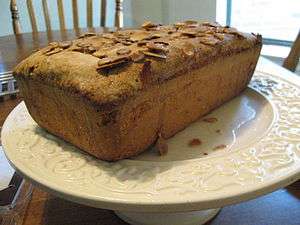Pound cake
|
A pound cake with almonds in an angled profile | |
| Place of origin | Great Britain |
|---|---|
| Main ingredients | Flour, butter, sugar, and eggs |
| Variations | Addition of flavourings or dried fruits |
|
| |
Pound cake refers to a type of cake traditionally made with a pound of each of four ingredients: flour, butter, eggs, and sugar. However, any cake made with a 1:1:1:1 ratio, by weight, of flour, butter, eggs, and sugar may also be called a pound cake, as it yields the same results. Pound cakes are generally baked in either a loaf pan or a Bundt mold, and served either dusted with powdered sugar, lightly glazed, or sometimes with a coat of icing.
History
It is believed that the pound cake is of northern European origin that dates back to the early 1700s. A recipe for pound cake is in the first American cookbook, American Cookery, which was published in 1796.[1]
Over time the ingredients for pound cake changed. Eliza Leslie, who wrote the 1851 edition of Direction for Cookery, used 10 eggs, beat them as light as possible, mixed them with a pound of flour, then added the juice of two lemons or three large oranges. This changed the flavor and texture of the cake. In the 2008 issue of Saveur, James Villas wrote that cake flour would not work in place of all-purpose flour because it lacks the strength to support the heavy batter.
An early variation on this cake replaced some of the flour with cornmeal made from dried corn (maize), which was then called Indian meal.[1] A recipe for Indian pound cake was first published in 1828 by Eliza Leslie and later included in The Indian Meal Book, which was published in London in 1846, when people in Ireland were looking for alternatives to expensive wheat flour.[1]
Variations
There are numerous variations on the traditional pound cake, with certain countries and regions having distinctive styles. These can include the addition of flavouring agents (such as vanilla extract or almond extract) or dried fruit (such as currants or dried cranberries), as well as alterations to the original recipe to change the characteristics of the resulting pound cake. For instance, baking soda or baking powder may be incorporated to induce leavening during baking, resulting in a less dense pound cake. A cooking oil (typically a vegetable oil) is sometimes substituted for some or all of the butter, which is intended to produce a moister cake. Sour cream pound cake is a popular variation in the United States, which involves the substitution of sour cream for some of the butter, which also is intended to produce a moister cake with a tangy flavor. Some of these variations may drastically change the texture and flavor of the pound cake, but the name pound cake is often still used. Some of the variations are described below.
American South style
A traditional American pound cake would contain one pound each of flour, butter, eggs, and sugar.[2] This recipe is quite popular in the cuisine of the Southern United States.
British style
Sponge Cake is the original British version of the American Pound Cake.
French style
In France, the pound cake is well known. The name of the pound cake "quatre-quarts", means four quarters. There are equal weights in each of the four quarters. In tradition, the popular cake of the French region of Brittany, as its name implies, uses the same quantity of the four ingredients, but with no added fruit of any kind. However, the Caribbean parts of the world that speak French traditionally add rum to the ingredients for Christmas Eve or even mashed bananas for extra moisture. In some cases the French might have beaten egg whites instead of whole eggs to lighten the batter. Other variants include adding chocolate or lemon juice for flavour.
Mexican style
In Mexico, the pound cake is called panqué. The basic recipe of Mexican panqué is much like the traditional U.S. recipe. Most common variants are panqué con nueces (pound cake with walnuts)[3] and panqué con pasas (pound cake with raisins).[4]
Venezuelan and Colombian style
Ponqué is the Venezuelan and Colombian version of the pound cake: the term ponqué is itself a Spanish phonetic approximation of pound-cake. The ponqué is essentially a wine-drenched cake with a cream or sugar coating, and it is very popular at birthdays, weddings and other social celebrations.
German style
.jpg)
The German Eischwerkuchen (Ei = egg, schwer = heavy, all ingredients weigh as much as the eggs each) is a recipe very similar to the pound cake. In German a pound cake is called Rührkuchen and is made according to the British or French recipe[5]
References
- 1 2 3 Byrn, Anne (2016). American Cake: From Colonial Gingerbread to Classic Layer, the Stories and Recipes Behind more than 125 of our Best-loved Cakes. Rodale. p. 21. ISBN 9781623365431. OCLC 934884678.
- ↑ Editors of Cooks Illustrated (2004) The New Best Recipe. Brookline, MA: America's Test Kitchen.
- ↑ Recipe of panqué with walnuts (in Spanish)
- ↑ Recipe of panqué with raisins (78yum/English)
- ↑ (German)
External links
| Wikibooks Cookbook has a recipe/module on |

